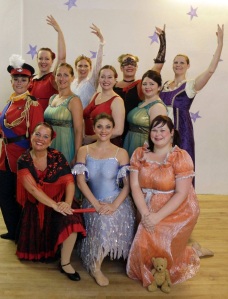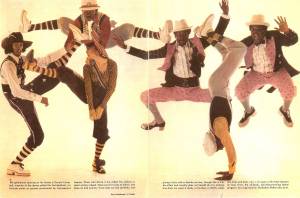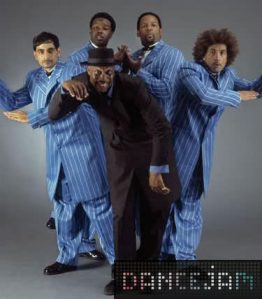We as dancers are faced with the scrutiny of body image day in and day out in many realms of our industry. 8 million people have been estimated to suffer from eating disorders. 10% of that is taken up by males. 1 in 5 female ballet dancers fight eating disorders. In a world where we are driven by beauty and image, and in an industry where you can be cut from an audition because you don’t look the part, there are very few beacons that encourage diversity in body type.
When I heard about a show on Ovation called Big Ballet, I was immediately drawn to it. Daniel Jones is the Artistic Director and Choreographer of the Big Ballet UK. They are a company made up of dancers of all shapes and sizes. I watched the show and fell in love with the idea of embracing someone’s passion and love for dance instead of limiting them due to their size.
I recently had the opportunity to interview one of their dancers, Donna Hargreave, about her time with the company and what she has learned throughout the process. Read on to see her side of dance!
DanceTchrProbs: Tell us a bit about your background as a dancer.
Donna Hargreave: I started to dance at the age of 4, I did all genres, ballet, tap, modern, tap and stage. From day one, I was hooked. I continued to dance until I was 18 years of age. At this point I reached a crossroads in my life. At only 4 feet 11 inches I am considered small in the dance world. So I followed my head and chose a career in Nursing, which I have to say I have never regretted. I never ever let the dance go, it is a passion, so I continued with adult classes, but mainly in modern and tap. I still do exams with the International Dance Teachers Association in tap.

DTP: What made you want to be a part of Big Ballet?
DH: Initially I was very unsure, as it would be a large undertaking and commitment. My husband, Nigel, family and dance teacher encouraged me to audition, as I think they realised how much I would gain from the experience. I wanted to be part of something that challenged the preconceived ideas is shapes, sizes and in my case age in the world of ballet. And hopefully inspire others and change, dance should be accessible to all!
DTP: I am located in the US and we only got about 5 episodes of the show. Is the company still together? Do you have an on running series still?
DH: Yes. 11 of the original 18 are still together, and have formed the company, Big Ballet UK, under the Artistic Direction of Daniel Jones. Although there are no plans as yet to televise more of our journey, the journey still continues. We train 1-2 times a week, doing Circuit training, classical ballet training and preparing choreography for new performances. In August we were fortunate to be invited to perform at the Royal Ballet School, London. We performed excerpts from The Nutcracker, choreographed by Daniel Jones.
DTP: Where did you find your biggest supporter? What about your biggest critic?
DH: In my younger years I am eternally grateful to my parents. I am the eldest of 4children, 3 girls all dancers. My parents never questioned a penny, despite money being tight. My dance teachers were and still are an inspiration, for the endless hours spent improving technique, sharing their dance knowledge and planting the seed of love for dance in my heart. I am my biggest critic!!!!!!
DTP: What about the company? Who was the biggest supporter? Biggest critic?
DH: Whilst training for the programme and to this day, the company ballerinas spend a lot of time together. We very quickly became a family, brought together from different backgrounds, through auditions with an overwhelming passion for dance. Daniel Jones, Monica Loughman, Wayne Sleep and the production company believed in us and the impact we could have on the dance world. I suppose we have many sceptics, who does not when they are trying to inspire change? But this is the Big Ballet Uk’s journey. It has been truly magical and continues to be so.

DTP: What is our favorite part about being a part of the Big Ballet?
DH: The chance to dance, ‘ live the dream’. At the age of 49, it’s the reawakening of endless possibilities. I have found the ballerina in me again.
DTP: What advice do you have for any dancer facing adversity because of body type?
DH: Embrace who you are. Celebrate your womanly curves, we are all a product of our relationships and life. Big Ballet Uk hopefully showed that whatever your size, shape, age, nothing is a barrier. Dance from the heart, beauty is from within.

DTP: What has been your favorite production?
DH: The two productions I have performed in, have been very different, mainlydown to the circumstances. Swan Lake, was a truly amazing experience, that started this magical journey, culminating into a great sense of achievement. The Nutcracker, with the new company and Daniel Jones, was equally as awe inspiring, but it also felt that it belonged to the ballerinas involved. With that comes a responsibility, which we embrace and a great sense of pride.
DTP: What inspires you?
DH: My children, Kathryn is 20, a dancer/dance teacher. Ben is 17, in upper sixth at school and captain of his senior rugby team. They are the best thing I have ever dine in my life, they accept me for who I am, support all I do, criticise me for all I do wrong! But most of all it’s the unconditional love.

DTP: Do you have any desire to choreograph or further the creative portion of your dance career?
DH: My real job is owner of a beauty salon and boutique with my sister Tracey. My job is fulfilling, creative fashion excites me, people interest me, and I get great satisfaction from helping ladies, play dress up and go home happy, feeling beautiful. These skills have also been of great help in my new role as Head Of Costume with Big Ballet Uk. I will definitely leave the choreography to our expert, Daniel Jones, he creates beautiful movement that compliments our diverse ballerinas.
DTP: What was the response to Big Ballet in the UK? Where are you located and where do you train?
DH: The response to Big Ballet, was phenomenal, beyond anyone’s expectations. We train 1/2 times a week, more if we have a performance, at Shona Boocock Academy Of Dance (one of the swans). Our journey and plans continue under the direction of Daniel Jones. All I can say, is watch this space!!!
DTP: What have you learned from being a part of the Big Ballet Uk?
DH: Patience. To believe in myself. I have a willingness to learn. I have an eagerness to please. I need to challenge myself. I also needed to fulfill a childhood dream.
I am 50 next year a milestone age, I am super excited about what life has in store for me. My new role as a ballerina, with Daniel Jones andBig Ballet, is the biggest challenge, but I know the rewards will be phenomenal. I am ready to work hard, fulfill my new role and enjoy every minute.

DTP: What is next for you and the Big Ballet?
DH: I am 50 next year a milestone age, I am super excited about what life has in store for me. My new role as a ballerina, with Daniel Jones and Big Ballet, is the biggest challenge, but I know the rewards will be phenomenal. I am ready to work hard, fulfill my new role and enjoy every minute.
For more information on Big Ballet UK, be sure to like their Facebook page and follow them on Twitter!









